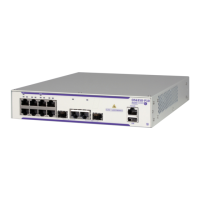Distributed Spanning Tree Commands
OmniSwitch 6250 CLI Reference Guide November 2009 page 16-169
Release History
Release 6.6.1; command was introduced.
Related Commands
MIB Objects
vStpInsPortTable
vStpInsPortAdminConnectionType
vStpInsPortAdminEdge
vStpInsPortAutoEdge
vStpMstInstanceNumber
vStpInsPortRole
vStpInsPortState
vStpInsPortPathCost
vStpMstVlanAssignmentTable
vStpMstVlanAssignmentVlanNumber
output definitions
Connection Type Operational connection type: PTP, NPT, NS (nonsignificant) or EDG.
Shows the current operational state of the port’s connection type. See
the bridge slot/port connection command on page 16-87 for more
information.
Edge Port Indicates whether or not the port is an edge port (YES or NO).
Boundary Port Indicates whether or not the port is a boundary port (YES or NO). A
boundary port connects an MST bridge to a LAN that belongs to a dif-
ferent MST region.
MST The Multiple Spanning Tree Instance (MSTI) number that is associated
with this port.
Role The role of the port for this Spanning Tree instance. Possible port roles
are: root, designated, alternate, master, and backup.
State The port operational state as defined by application of the Spanning
Tree Protocol. Possible port operational states include: disabled, block-
ing, listening, learning, and forwarding.
Pth Cst The contribution of this port to the path cost towards the Spanning Tree
root bridge that includes this port. Path cost is a measure of the distance
of the listed port from the root bridge in the number of hops.
Vlans The VLAN ID of the default VLAN for the port.
show spantree cist ports Displays Spanning Tree port information for the flat mode Common
and Internal Spanning Tree (CIST) instance.
show spantree msti ports Displays Spanning Tree port information for a flat mode Multiple
Spanning Tree Instance (MSTI).
show spantree 1x1 ports Displays Spanning Tree port information for a 1x1 mode VLAN
instance.

